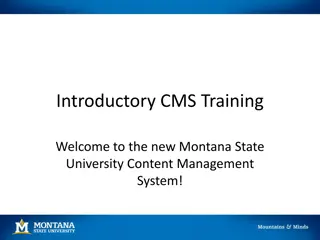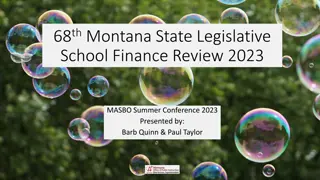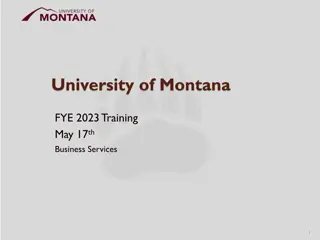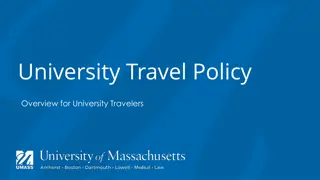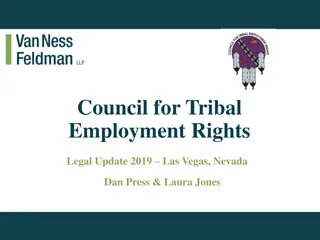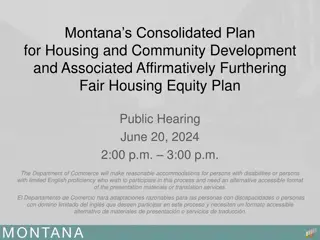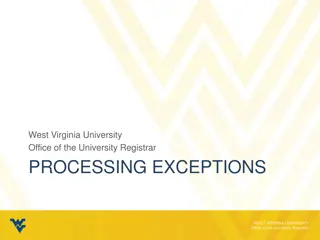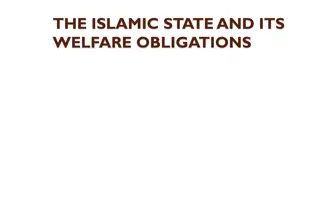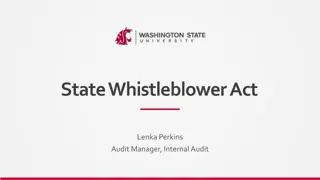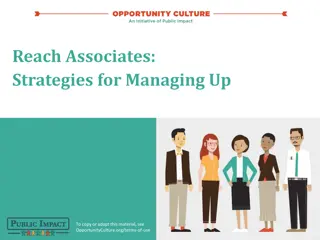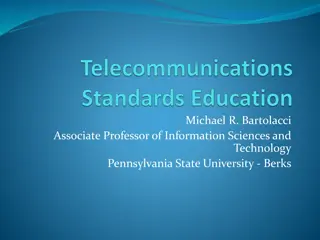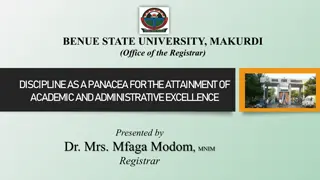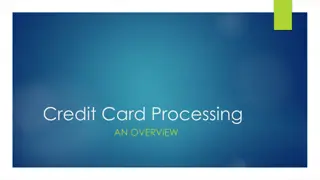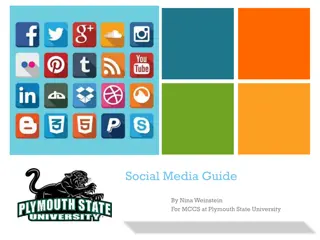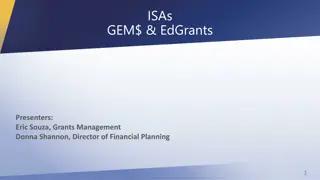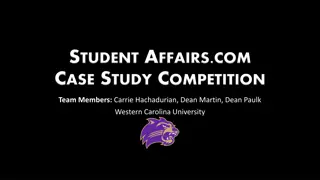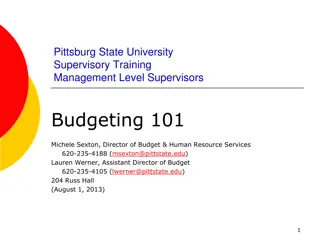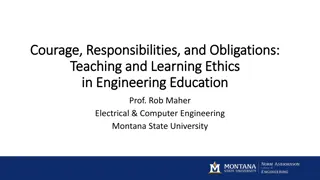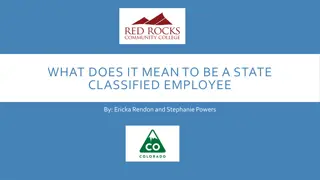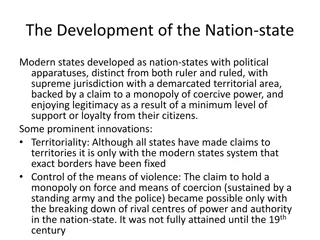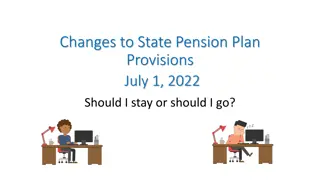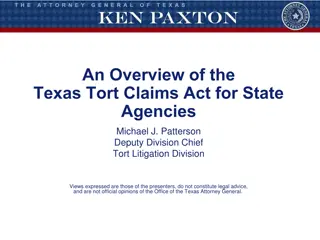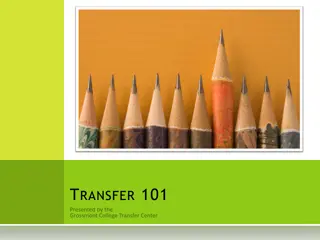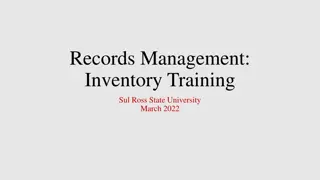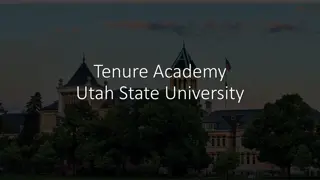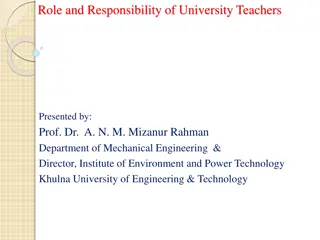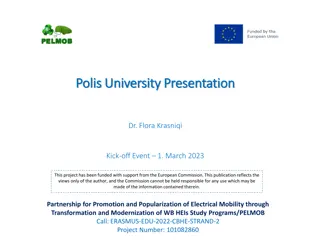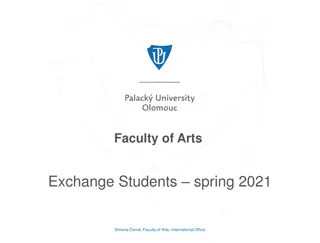Managing Subawards at Montana State University: A Guide
Providing basic information and resources for managing subawards at Montana State University's Office of Sponsored Programs. Topics covered include the definition of subawards, why they are issued, how they get issued, responsibilities of the pass-through entity, processing subaward invoices, and subaward closeout procedures. Learn about what subawards are, why MSU issues them, and the process for initiating subawards shared between OSP and the PI.
Download Presentation

Please find below an Image/Link to download the presentation.
The content on the website is provided AS IS for your information and personal use only. It may not be sold, licensed, or shared on other websites without obtaining consent from the author. Download presentation by click this link. If you encounter any issues during the download, it is possible that the publisher has removed the file from their server.
E N D
Presentation Transcript
Montana State University Office of Sponsored Programs Subaward Management May 2021
ObjectiveProvide basic information and resources for helping manage subawards
Topics Definition of Subaward Why Issue a Subaward? How Does a Subaward get Issued? What are the Responsibilities of the Pass-Through Entity? (MSU) How to Process a Subaward Invoice Subaward Closeout
What is a Subaward? Per the Uniform Guidance (200.92): Subaward means an award provided by a pass-through entity (MSU) to a subrecipient for the subrecipient to carry out part of a Federal award received by the pass-through entity. It does not include payments to a contractor or payments to an individual that is the beneficiary of a Federal program. A subaward may be provided through any form of legal agreement, including an agreement that the pass-through entity considers a contract. MSU is referred to as the Pass-Through Entity (PTE) and the entity receiving the subaward is referred to as the Subrecipient.
Why does MSU issue Subawards? An MSU researcher may want to include another scientist or collaborator from outside our institution who can bring expertise or special skills to the proposed project. This can strengthen the proposal being submitted to the sponsor and can increase the chances that an award will be made over the chances if only MSU researchers are involved. If a specific subrecipient is listed in the proposal it is critical to have that subrecipient conduct that portion of the project.
How does a Subaward Get Issued? Information is requested from Subrecipients at the proposal stage It may vary depending on the agency and/or the Request for Proposal (RFP) but typically at least a Letter of Intent or Letter of Commitment, a Statement of Work (SOW), a budget estimate and sometimes a schedule and/or deliverables. The Letter of Intent is typically signed by an Authorized Representative at the subrecipient s institution. TIP: Subrecipients are allowed to include their entity s F&A rate in their budget; if there is an F&A cap from the sponsor, both the PTE (MSU) and the Subrecipient are held to that cap.
Who is responsible for initiating the subaward? This is a shared responsibility between OSP and the PI. When a grant is opened with a subaward budget, the eOpen memo will include a link to the OSP Subaward web page and provide the subaward contact info (subawards@montana.edu ). The PI is responsible for collecting and approving the appropriate subaward documents, and for forwarding the request to OSP. See the OSP Website: Subawards and Working with Other Institutions for forms and instructions. OSP is responsible for reviewing the information provided by the PI, completing the risk assessment process, and drafting and executing the agreement. TIP: Subawards are not automatic and do not get set up just because the grant is established. The same is true for amendments: if the grant gets an extension of time and/or funding, it does not happen automatically on the subaward.
What are MSUs responsibilities for monitoring subawards? Per the Uniform Guidance, 200.332 - MSU is responsible for managing and monitoring the programmatic, financial and other compliance related aspects of the subaward. MSU will be acting in the capacity of the Federal agency. MSU has the same responsibilities for ensuring that the Federal funds are being spent appropriately and that all of the deliverables are met. MSU utilizes standard subaward agreements that are the industry standard and flows down requirements and Terms & Conditions received as the Prime to each subrecipient to ensure all parties are aware of the requirements of the award. Flowing down these requirements is one way we distinguish between a Subaward and a Contracted Services arrangement; the Terms & Conditions imparted to a Subrecipient are the same as those imparted to MSU.
Who at MSU is responsible for subrecipient monitoring? This is a shared responsibility between OSP, the PI, and the department or FSS. Departments and/or FSS are responsible for assisting PI s with receipt, review, and processing of invoices received from subrecipients. PI is responsible for reviewing invoices for allowable costs per the subrecipient Scope of Work and per the subaward budget, for ensuring technical progress, and collecting final reports/deliverables from subrecipients. Departments and/or FSS are responsible for preparing the BPAs and submitting to University Business Services for data entry and for routing to OSP. OSP is responsible for issuing subawards, issuing modifications to subawards, ensuring subaward terms fall within the parameters of the prime award, completing ongoing risk assessments as needed, maintaining subrecipient compliance records for Human Subjects and Animal work, final review and release of subaward BPAs, and subaward closeout.
Departmental/FSS review of subrecipient invoices should verify: Subaward ID # is listed on the subrecipient invoice Period covered by invoice is identified Columns for Current and Cumulative Costs are included If the prime grant is Federal, the Uniform Guidance language regarding truth and accuracy is included.* Invoice is signed and dated by subrecipient If subaward includes Cost Sharing, it is documented along with the invoice. If criteria above are incorrect, work with subrecipient to get corrected invoice before processing further. TIP: In the subaward agreement, Attachment 6 Invoicing Instructions, identifies these requirements.
Departmental/FSS review of subrecipient expenditures should verify: Expenses fall within Period of Performance (POP) of the subaward. Total Cumulative amount on invoice does not exceed the subaward Authorized Amount. Cumulative amount agrees with your payment history records. Invoice Period follows previous Invoice Period. (Invoices in sequence, none missing) TIP: If criteria above are incorrect, you may email subawards@montana.edu to resolve before processing further. It could be an amendment to the subaward is in the works, for example. We are happy to help!
Departmental/FSS BPA preparation: Before submitting the BPA, there must be approval to pay from PI/BOM/FOM. If subrecipient indicates Final Bill, MSU PI must explicitly approve as the Final bill. Include required UBS info on BPA cover page: Vendor ID Remit info box: subrecipient invoice number, subrecipient invoice date Also include Subaward ID and Invoice Period in Remit info on BPA. Vendor address entered on BPA is the Remit to address listed on subrecipient invoice. Use correct account code (621471 first 25K, 621472 over 25k).* *For continuation subawards (same Scope of Work, new subaward ID), BPA will use 621472 once requirement of 25K met on project (incl. expenses on previous subaward). When in doubt, please feel free to verify with OSP.
BPA Processing after BPA Preparation BPAs are submitted to UBS. BPAs are data entered by UBS, then released to the OSP approval queue. Subaward BPAs released to the OSP approval queue are identified in an automated daily report and assigned to the Subaward Specialist for processing.
Once to OSP, the OSP BPA review includes: Invoice amount matches BPA cover sheet amount Subaward ID and Invoice period correctly documented in Remit area of BPA. Remit info is entered correctly in Banner Use of correct account code on BPA; account code correctly entered in Banner Invoice has approval to pay from PI or BOM/FOM If Final, invoice is explicitly approved as Final by PI Correct Vendor ID and address identified on BPA and entered in Banner; address should match the Remit to address on the subrecipient invoice
OSP Subrecipient invoice review includes: Grant requirements are met: Grant has sufficient funding to cover payment. Grant has sufficient subaward budget to cover payment. Subaward expenses within grant Period of Performance. Expenditures are allowable per grant/ per Uniform Guidance.
OSP invoice review contd: Subaward requirements are met: Subaward has sufficient funding to cover payment Subrecipient cumulative expenses do not exceed subaward Authorized Amount Subaward expenses within subaward Period of Performance Subrecipient expenses are in line with subaward budget, and no subaward budget category is overspent IDC is being applied and calculated properly Tip: Cover Page and Attachment 5 of the subaward agreement are used to verify this information
27.06% of all Subaward BPAs Submitted 3/17-4/26/21 had errors that resulted in processing delays 621471 vs 621472 8% Backup doc missing/incompl 23% Sub Inv Unsigned 14% Sub Exp not in Sub POP 9% Calc errors sub inv (cum.) 6% Sub inv missing format req. 3% Sub Exp > Sub Auth Amt 6% Inv period out of seq (miss/overlap) 31% 59% - Verifiable at the Department/FSS Level 41% - Verifiable at the UBS/OSP Level Of the 27.06% :
Subaward BPA Cover Page % of missing or incorrect information 3/17-4/26/21 52% 6% 18% 3% 1% 5% 83% Total Subaward BPAs (218) Remit Box Info Commodity Info Vendor Info Inv Date Inv # SubID# Inv Per Acct Code Amount Remit address
Why BPA collaboration? If some departmental/FSS BPA elements are submitted incorrectly, UBS may catch and must correct during data entry. Any other errors must be corrected by OSP during the OSP approval process. The further into the routing process a BPA is when an error is caught, the more steps there are to correct. For example: BPAs may have to be disapproved BPA cover pages may have to be annotated in EDM Banner data may have to be entered or corrected BPAs may get held to follow up with the subrecipient Corrected subrecipient invoices may have to be uploaded to EDM and updated in the departmental /FSS records Additional Banner data may have to be entered These steps result in delays in making payments.
Subaward Closeout Payment of Final Invoice to subrecipient will trigger subaward closeout process. Closeout Certification email and memo sent to MSU PI and Subrecipient PI. (All subaward contacts are also cc d.) PIs are certifying: All deliverables met, including reports and cost sharing All expenses submitted to and paid by MSU All new technologies (inventions and innovations) are documented OSP verifies subrecipient compliance documentation is complete, including capital equipment reports if required. Prime grant can not be closed until all subawards have been certified for closeout by both PIs.
Questions? Want more training? Contact Subawards at: subawards@montana.edu


